Fanmode interview: Bryan Wilkinson (part 5)
Long-time Micronauts and Microman fan, Bryan “MicroBry” Wilkinson, is one of the select few who’ve made the transition from toy fan to toy designer. His website was one of the earliest to draw attention to Transformers’ (then) little-known origins, and he was given the opportunity to work on Palisades’ Micronauts revival in 2002. As Transformers celebrates its 25th. anniversary and Microman celebrates its 35th., we thought it only appropriate to ask him about Micronauts, Microman, Transformers, fandom, and making the transition from consumer to creator.
(Due to its length, the interview is presented in several parts. Parts one, two, three and four were published earlier.)
What is Takara SF Land?
Takara SF Land is the term sometimes used by fans to refer to Takara’s science-fiction-themed toys starting in the early 70’s with Henshin (Transforming) Cyborg. It not only includes Henshin Cyborg, Microman, and Diaclone, but also a number of smaller lines such as Magnemo (see also: 2, 3, 4, 5, 6, 7), Blockman, Bloccar, Timanic, and others, and is generally associated with the latter part of the Showa era of Japanese history (1926-1989), as are most of the old “classic” mecha and hero-robot properties.
Most of these toys tend to share interchangeability across the lines either with 5mm or magnetic “magnemo” joints and often have electronic/cybernetic detailings and other shared stylistic resemblances and art direction. Much of the style was influenced by popular Showa era SF-themed artists such as Ishinomori Shotaro, Matsumoto Leiji, and Nagai Go, and more than a few contributing freelancers who were or became well-known mecha designers in the anime industry.
While the Takara SF Land era is generally considered to run up to the advent of the Transformers, Transformers also inherited this legacy as many of the designers still working with Takara in 1985 on the SF Land properties went on to work on Transformers.
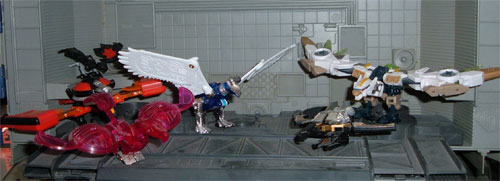
Photo copyright © Bryan Wilkinson. Used with permission.
(Click on the photo for a better look.)
What recurrent design themes have you noted in Takara’s lines?
The use of translucent parts juxtaposed with cybernetic (and often chromed until recent years) details was a core motif of all Takara SF Land toys that should be recognizable by fans as part of the Transformer style even today.
The idea behind Henshin Cyborg #1 was that the clear body gave an “x-ray view” of the figure’s internal chrome mechanical parts. This was much like the popular “Visible Man” kits of the day which were clear plastic models of people that showed their skeletons and innards inside. Henshin Cyborg #1 did actually have an “alt mode” in the form of additional modules he could be plugged into that changed him into a motorcycle, again sharing the clear and chrome style, making his human form blend completely into that of the bike. He also had many mechanical attachments that could replace his hands and feet with all manner of gadgetry.
Cyborg Jaguar, a Henshin Cyborg #1 companion, was a posable toy jaguar toy that also had a clear exterior and a chrome robotic interior. It had a number of attachment accessories and costumes (including of other animals such as dobermans and lions). Similarly, a condor was planned but never made it to production. But the idea of cybernetic animals, particularly jaguar and condor body-types, was not one that would die anytime soon at Takara. Microman would later feature the Titan DoberMachine and MagneCondor companion robots, which could magnetically change into vehicles. These were the inspiration for the Micro Change MicroCassetteRobo in the 80’s that became Ravage and Laserbeak. The Titan DoberMachine looks much like Ravage, and the cybernetic details inside the wings of the Titan MagneCondor presage Laserbeak’s wing details by nearly a decade.
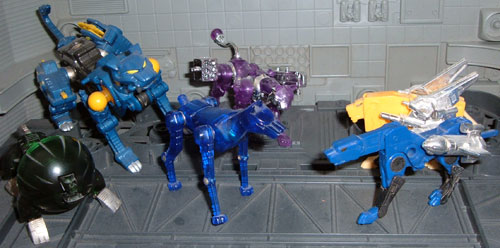
Photo copyright © Bryan Wilkinson. Used with permission.
(Click on the photo for a better look.)
The initial Microman Zone figures were molded in translucent plastic and engineered to look similar to Henshin Cyborg. They were too small to have chrome parts inside them, so they were fitted with colored-chrome chest plates. The heads were also chromed, which was to simulate the cyborg look of the original Henshin Cyborg’s head, and this would become a part of Microman’s identity forever.
The Microman Zone figures were pretty close in function to their 12-inch Henshin Cyborg kin, and you could remove the articulated hands and feet to attach equipment. However, as vehicles and bases were introduced, these used 5mm pegs and sockets to allow for interchangeable parts that could be swapped out, such as wheels, wings, rockets, guns, etc. It wasn’t long until this play feature was incorporated into the Microman figures themselves, with 5mm sockets added to the back of the figure and at the bottom of shoes making it easier for the Microman figures to link to their equipment. With this standard in place, Takara would stick to 5mm connections as a mainstay in most of its subsequent toylines, allowing interchangeability between toys across the decades. Transformers fans who have swapped parts between toys over the years are in a particularly good position to appreciate this, even more so since it was key play feature for the Energon and Armada lines.
Why did Takara settle on the 5mm size for its peg/port-based interchangeability?
Takara first started using it on some Henshin Cyborg toys before Microman came along, and it became standardized for Microman after the initial set of Microman Zone vehicles. Once those were out, the designers credited Lego as inspiration for moving to 5mm interchangeable parts, and indeed Lego also uses 5mm as its standard. But they made it clear that this was after Microman had already started, so obviously the 5mm parts predate this influence.
I’ve noticed the old tooling of Takara’s toys (and even in much of the modern tooling on Transformers) uses a standard 5mm socket size for screw-holes, which allows additional ports to connect a 5mm part to even if it wasn’t intended for that purpose. I would assume that this has always been a standard tooling size with Takara’s equipment, particularly in the old days when they did their manufacturing domestically. It would have been convenient at the time to manufacture parts using this tooling for pegs and sockets.
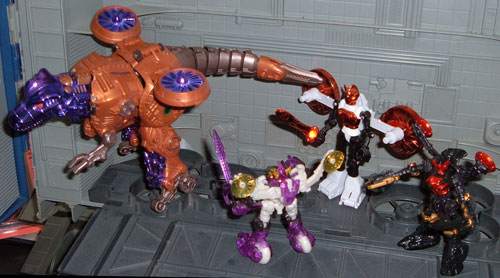
Photo copyright © Bryan Wilkinson. Used with permission.
(Click on the photo for a better look.)
What would surprise a casual Transformers fan about the line’s history?
By now a larger number of Transformer fans may be aware of the origins of the toys, but there’s still a lot of basic stuff that more casual fans don’t know.
Generation 1’s first wave of toys came from Takara’s Microman and Diaclone line so many quirks are the more obvious legacies from those two lines. The Diaclone toys, which were mostly 1/60 scale, were meant to be piloted by small Inch-Man figures (which were loosely based on Microman figures). This was why there were so many access hatches to empty seats on the Transformers Autobots, the Seeker jets, the Dinobots, and even the Insecticons.
The remaining Transformers that came from Microman were household items, toy cars, and toy guns that never meant to “mass-shift” to keep their robots to scale with the Diaclone robots, but were meant to change to 1/1 scale robots and stay at their toy’s size.
I’ve noticed that some fans unfamiliar with the origins will go so far as to describe the features on some of these toy sculpts as being meant to look sinister. This shows how much a good backstory and character development can drastically change perceptions because none of the Microman toys re-released as Transformers (Megatron, Soundwave, Laserbeak, Ravage, Rumble, etc.) were evil in their original series. They were all androids that fought on the Microman side.
Of the Diaclone-based toys, the Insecticons are the only ones from G1 that are on the enemy’s side. The Waruder Insecter Robos in Diaclone were used as insectoid mecha by the evil Waruder aliens. (The Waruders took their name from King Walder, the enemy of Henshin Cyborg.)
The Dinobots are the legacy of another Takara property, Machine Saurer, which featured a clear-with-chrome-innards Godzilla-like monster. Machine Saurer was revived in Diaclone as Machine Dragon as the Waruder opponent for the Diaclone Dinobots, which were loosely inspired by unused cybernetic dinosaur designs from Machine Saurer (these designs were even more heavily borrowed from later during the Pretenders series). These designs were all by Adachi Tatsuo and Ishikawa Ken of Dynamic Productions, who contributed to many of Nagai Go’s classic super robot series. (One such series was the 1975 super robot Koutetsu Geag, whose main character could change into the head of his robot. This was the direct inspiration for the Japanese Transformers series, the Headmasters.)
The Japan-only Transformers Victory and Transformers Zone series also take their names from the 1974-1975 Microman/Henshin Cyborg crossover, Victory Project, and Microman Zone respectively. Even the Micromasters were meant partly as a reference-in-name to their Microman and Micro Change ancestors.
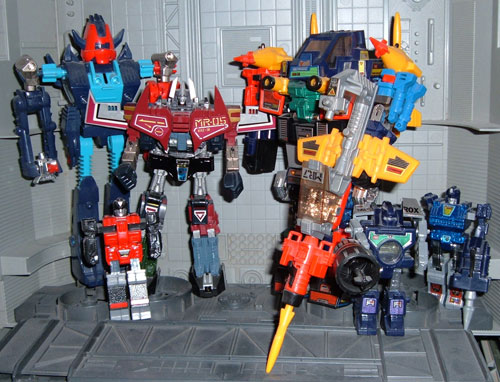
Photo copyright © Bryan Wilkinson. Used with permission.
(Click on the photo for a better look.)
What other design influences did Microman have on Transformers?
Microman featured many robots and figures that could transform through parts-swapping into cars, jets, saucers, and more. The first large Microman playset, the Conning Tower M115 (known to Micronauts fans as Mobile Exploration Lab), was essentially a fusion of giant robot and starship with a number of alternate modes. Takara’s first bulky robot toy, the foot-tall Robotman from 1975 (known as Biotron in the Micronauts) was actually something of a very primitive “parts-former” with a simple self-contained motorized tank-like mode and his boots became abstractly bike-like vehicles.
One Microman vehicle of note was the 1977 Cosmo Countach. (Editor’s note: scroll down to the 03.9.23 entry.) The Countach’s rear portion could change to a robot mode mimicking the style of the Gimca Titan Command’s “linked” mode. The Cosmo Countach is almost certainly an inspiration for the Ohno Koujin’s first Diaclone Car Robot design (which would eventually become Sunstreaker).
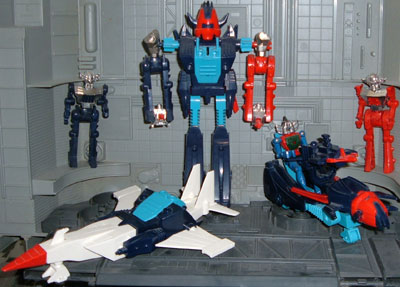
Photo copyright © Bryan Wilkinson. Used with permission.
(Click on the photo for a better look.)
The first Acroyear robot, Giant Acroyear, was a gestalt robot that could be transformed into a wicked F-15-like alien jet mode with his arms becoming two regular-sized Acroyear figures and his legs, head and wingpack forming a mobile gunning platform. Giant Acroyear was the first such gestalt robot toy from Takara, probably influenced by the success of Nagai Go’s Getter Robo. This was likely the influence for later Microman gestalt robots. The 7-2-1 Formation MicroRobot featured a large robot made up of 7 smaller robots, and like Giant Acroyear, had red and blue robots in a similar configuration for its arms. The various New Microman gestalt MicroRobot sets in turn influenced the introduction of gestalts in Diaclone later.
That robot style would be the main influence on the look of Micro Change, and is particularly noticeable in the three robots that make up the Microx CameraRobo—better known to TF fans as Reflector. When Hasbro exhausted Takara’s existing toy designs for Transformers during the G1 era, Takara had to keep similar product flowing to keep up with demand so Takara created more mini-car-based toys (which were an extension of the Micro Change MicroRobot Car) and MicroCassetteRobo-inspired cassettes with the style consistent across the transition. The Micro Change legacy would live on decades later through the Transformers Real Gear Robots line of toys.
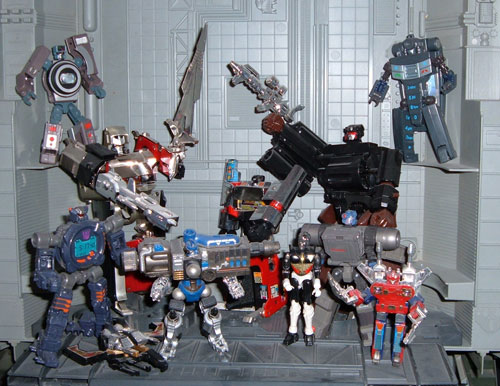
Photo copyright © Bryan Wilkinson. Used with permission.
(Click on the photo for a better look.)
The US-developed Action Masters line was particularly Microman-like, complete with O-ring hip construction, a 5mm socket on the back, and a focus on action figures with vehicles and interchangeable 3mm and 5mm parts.
It’s appropriate that years later, the 2000 LED Powers Microman line would recycle a number of Transformers molds including Action Masters Optimus Prime’s truck, the Micromaster rocket base playset, and Laser Cycles (with handlebars retooled to fit Microman hands). And even more recently the original, properly microscope-colored (black and silver) Micro Change version of Perceptor was rereleased as the Decepticon Magnificus with Ga’Mede, a silver-haired Microman figure in a G.I. Joe Cobra-style outfit. Around this time, a Microman version of the Transformer character Kicker was also released. So, the interrelationship between both series has continued.
It’s also interesting to note that Transformers Animated’s character designer Derrick Wyatt is openly a big Microman/Micronauts fan and has confessed to some subtle influences on his work, and that popular Transformer artist Don Figueroa has also incorporated some homages into his own work. I think that it’s great that even Western artists associated with Transformers not directly part of Takara’s own design team have been conscious of the series’ roots and have maintained that continuity of style that flows through the generations of these toys and the characters that have spawned from them.
It was the iconic designs of the original toys that incorporated the feel and character of their alternate mode into their robot mode, mixed with a stylized cybernetic futuristic aesthetic that made them so otherworldly, memorable and pleasing to the eye. I hope this tradition of inspired design rooted in the history of Takara’s SF Land will continue for generations more to come.
